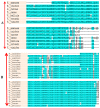Anthocyanin Accumulation in Muscadine Berry Skins Is Influenced by the Expression of the MYB Transcription Factors, MybA1, and MYBCS1
- PMID: 27754335
- PMCID: PMC5187533
- DOI: 10.3390/antiox5040035
Anthocyanin Accumulation in Muscadine Berry Skins Is Influenced by the Expression of the MYB Transcription Factors, MybA1, and MYBCS1
Abstract
The skin color of grape berry is very important in the wine industry. The red color results from the synthesis and accumulation of anthocyanins, which is regulated by transcription factors belonging to the MYB family. The transcription factors that activate the anthocyanin biosynthetic genes have been isolated in model plants. However, the genetic basis of color variation is species-specific and its understanding is relevant in many crop species. This study reports the isolation of MybA1, and MYBCS-1 genes from muscadine grapes for the first time. They are designated as VrMybA1 (GenBank Accession No. KJ513437), and VrMYBCS1 (VrMYB5a) (GenBank Accession No. KJ513438). The findings in this study indicate that, the deduced VrMybA1 and VrMYBCS1 protein structures share extensive sequence similarity with previously characterized plant MYBs, while phylogenetic analysis confirms that they are members of the plant MYB super-family. The expressions of MybA1, and MYBCS1 (VrMYB5a) gene sequences were investigated by quantitative real-time PCR using in vitro cell cultures, and berry skin samples at different developmental stages. Results showed that MybA1, and MYBCS1 genes were up-regulated in the veràison and physiologically mature red berry skins during fruit development, as well as in in vitro red cell cultures. This study also found that in ripening berries, the transcription of VrMybA1, and VrMYBCS1 in the berry skin was positively correlated with anthocyanin accumulation. Therefore, the upregulation of VrMybA1, and VrMYBCS1 results in the accumulation and regulation of anthocyanin biosynthesis in berry development of muscadine grapes. This work greatly enhances the understanding of anthocyanin biosynthesis in muscadine grapes and will facilitate future genetic modification of the antioxidants in V. rotundifolia.
Keywords: MYB gene; MYBCS1; MybA1; anthocyanins; antioxidants; muscadine grapes; pigments.
Conflict of interest statement
The authors declare no conflict of interest.
Figures







References
-
- Georgiev V., Ananga A., Tsolova V. Wine Safety, Consumer Preference, and Human Health. Springer; Cham, Switzerland: 2016. Dietary supplements/nutraceuticals made from grapes and wines; pp. 201–227.
-
- Ananga A., Phills B., Ochieng J., Georgiev V., Tsolova V. Production of Anthocyanins in Grape Cell Cultures: A Potential Source of Raw Material for Pharmaceutical, Food, and Cosmetic Industries. InTech Open Access Publisher; Rijeka, Croatia: 2013.
-
- Samuelian S.K., Camps C., Kappel C., Simova E.P., Delrot S., Colova V.M. Differential screening of overexpressed genes involved in flavonoid biosynthesis in North American native grapes: “Noble” muscadinia var. and “Cynthiana” aestivalis var. Plant Sci. 2009;177:211–221. doi: 10.1016/j.plantsci.2009.05.013. - DOI
LinkOut - more resources
Full Text Sources
Other Literature Sources

